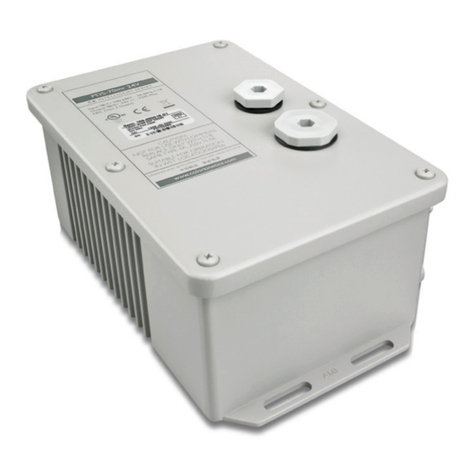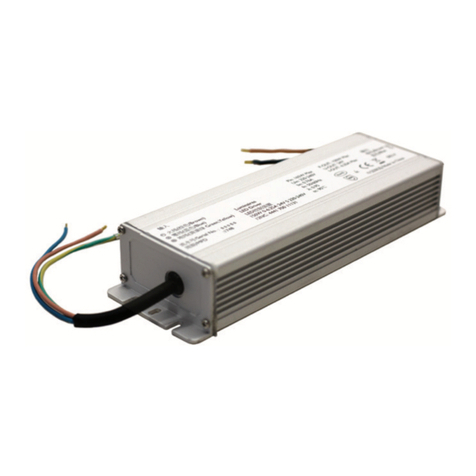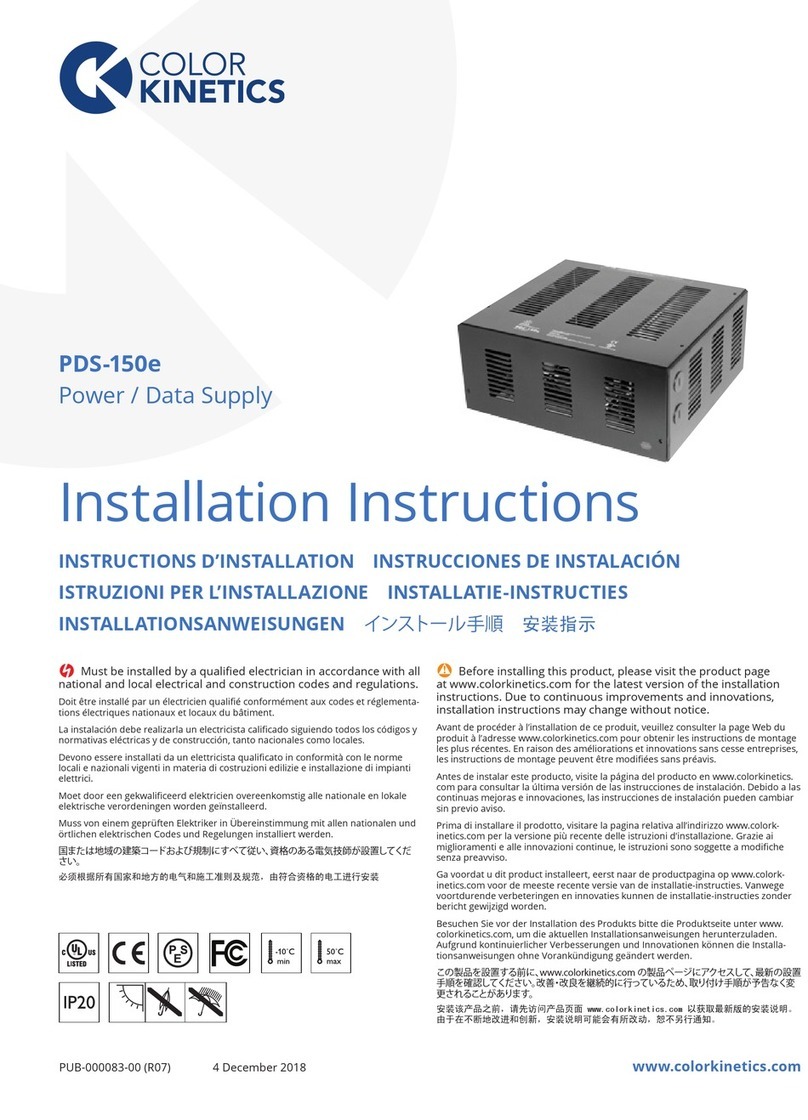
GETTING STARTED
Color Kinetics'®sPDS-60ca 24V is a compact power/data supply
for indoor installations. sPDS-60ca 24V provides power and data to
Color Kinetics' 24VDC Chromasic®driven product lines, and is avail-
able for DMX and Ethernet control options.
The "s" type of power supply provides additional features, such as
base address and grouping of light fixture addresses, without the
need for external components
This guide contains important information on installing and using your
new sPDS-60ca 24V. Please read it carefully and save it for future
reference.
Included In This Box
• Power/data supply
• US Grounded IEC Cord Set
• RJ-45 Terminator
• User Guide
Additional Items Needed
• Mounting hardware -- 4 flat head screws M3.5 or #6
Scope of this User Guide
The goal of this user guide is to explain the steps necessary to install
sPDS-60ca
24V
for DMX and Ethernet control to assure peak perfor-
mance. Its intended use is for reference only, by persons who are fully
qualified. This document should never be considered a substitute for any
provisions of a regulation or state and/or local code.
Identification and Warnings of Safety Hazards
In accordance with ANSI Z535.4-2002, the following system identi-
fies the severity of the hazards associated with the products:
“danger” Imminently hazardous situation which, if not avoided, will
result in death or serious injury.
“warning” Potentially hazardous situation which, if not avoided,
could result in death or serious injury.
“caution” Potentially hazardous situation which, if not avoided, may
result in minor or moderate injury or property damage.
Also used to alert against unsafe practices.
ignoring ahazard will void any warranty.
warning: Ensure that power is disconnected before installing, wiring,
or servicing the sPDS-60ca 24V power supply.
warning: The sPDS-60ca 24V power supply must be installed by a
qualified professional in accordance with NEC and relevant local
codes.
warning: Do not attempt to install or use sPDS-60ca 24V until you
read and understand the installation instructions and safety labels.
warning: Do not use sPDS-60ca 24V if power cables are damaged.
warning: This is a class A product. In a domestic environment this
product may cause radio interference in which case the user may be
required to take adequate measures.
caution: Ensure that sPDS-60ca 24V is securely attached, properly
mounted, and free of excessive vibration.
caution: Do not hot swap. Ensure the power supply is off before
connecting or disconnecting fixtures.
caution: Do not modify or alter sPDS-60ca 24V.
note:The instructions and precautions set forth in this installation
guide are not necessarily all-inclusive or relevant to all applications as
Color Kinetics cannot anticipate all conceivable or unique situations.
Owner/User Responsibilities
It is the responsibility of the contractor, installer, purchaser, owner,
and user to install, maintain, and operate sPDS-60ca 24V in such a
manner as to comply with all state and local laws, ordinances, regula-
tions, and the American National Standards Institute Safety Code.
note:sPDS-60ca 24V is shipped with a US IEC power cable. For
international customers, use a country-specific IEC cable meeting the
following specifications: 3-conductor, 18AWG (1.00mm2), HAR rat-
ing for Europe, and JET rating for Japan. (Hard Service Type ST or
equivalent.)
note:Ensure the IEC inlet plug fits in the supplied lock. The lock may
not accommodate all plug styles.
INSTALLING sPDS-60ca 24V
sPDS-60ca 24V must be installed by a qualified electrician in accor-
dance with NEC and relevant local codes for power supplies. A
power screwdriver is recommended for mounting the unit.
Mounting the Housing
• Select the location to mount the housing, keeping sPDS-60ca 24V
within the maximum distance specified for your fixture. Refer to your
fixture user guide for the cable run information.
NOTE: Ensure that there is adequate space to make all connections
to the front and rear of the unit.
• Mount the housing to a flat surface using four M3.5 or #6 flat head
screws suitable for the mounting surface. Mounting slots are located
on each end of the housing. See Fig. 1.
NOTE: Do not overtighten the mounting screws.
WIRING sPDS-60ca 24V
After mounting the power/data supply, you are ready to connect
power, lights, and data to sPDS-60ca 24V.
Connecting Lights to sPDS-60ca 24V
• Plug the leader cable connector into a power output receptacle on
the front of sPDS-60ca 24V. Power outputs are labeled Out 1 and
Out 2. See Fig. 2.
note:When using one light run per sPDS-60ca 24V, use Output 1.
• Refer to the user guide for your lights to determine maximum
number of lights per power/data supply and specific wiring
requirements.
Connecting DMX Data to sPDS-60ca 24V
sPDS-60ca 24V receives DMX data from, and can be controlled by,
Color Kinetics' full line of DMX512 controllers or any third party
DMX512 controller.
• Plug the data RJ-45 connector from the controller into the DMX IN
port.
• To daisy-chain DMX data to another sPDS-60ca 24V, connect a
CAT5 cable with RJ-45 connectors between the DMX OUT port of
the first unit and the DMX IN port of the next unit. Plug a terminator
into the DMX OUT port of the last power supply in a data chain.
See Fig. 3.
Connecting Ethernet Data to sPDS-60ca 24V
sPDS-60ca 24V receives Ethernet data from Color Kinetics' Light
System Manager (LSM) or Video System Manager (VSM). LSM con-
sists of Light System Composer software and Light System Engine
hardware, and VSM consists of Video System Manager software and
Video System Engine hardware. A dedicated network and one or
more Ethernet switches are required for your installation. See Fig. 4.
Refer to the LSM User Guide or VSM User Guide for setup and con-
figuration information.
• Connect the CAT 5E data cable, with RJ-45 connectors on both
ends, to the Ethernet switch and to the ENET IN port on the sPDS-
60ca 24V power/data supply.
note: End-run Ethernet data to each sPDS-60ca 24V in an installation.
Ethernet cannot be daisy chained. See Fig. 4.
Connecting Power to sPDS-60ca 24V
• Connect the IEC power cable to the back of sPDS-60ca 24V. Plug
the IEC power cable into a standard 100-240VAC outlet. Tighten
the screw to secure the clamp. See Fig. 5.
ADDRESSING THE LIGHTS
When using the DMX control input, you are required to set the base
address for sPDS-60ca 24V and configure the lights connected to it.
The base address for the supply will be the starting address for the
first light connected to Output 1. You can also group more than one
fixture to the same address or reverse the addressing sequence of the
fixtures on Output 1.
Setting Base Addresses
1. Press and release the UP or DOWN address buttons to step
through the base address. The address numbers 1 through 170
will appear in the display. Press and hold either button to rapidly
advance to the desired light number. Stop when the desired base
number appears on the display. See Fig. 6.
sPDS-60ca 24V
DMX/ETHERNET
user guide
Color Kinetics Incorporated
10 Milk Street, Suite 1100
Boston, MA 02108
Tel 888 Full RGB
Tel 617 423 9999
Fax 617 423 9998
www.colorkinetics.com
ITEM# 109-000021-02 (DMX/Ethernet)
This product is protected by one or more of the following patents: U.S. Patent Nos.
6,016,038, 6,150,774 and other patents listed at http://colorkinetics.com/patents/.
Other patents pending.
©2005 Color Kinetics Incorporated. All rights reserved. Chromacore, Chromasic,
Color Kinetics, the Color Kinetics logo, ColorBlast, ColorBlaze, ColorBurst, ColorCast,
ColorPlay, ColorScape, Direct Light, iColor, iColor Cove, iPlayer, Optibin, QuickPlay,
Sauce, the Sauce logo, and Smartjuice are registered trademarks and DIMand,
IntelliWhite, Powercore, Video With Light, and Light Without Limits are trademarks of
Color Kinetics Incorporated.
PUB-000148-00 Rev 00
8.31”
(21.2 cm)
2.25”
(5.7 cm)
Fig. 1
OUT 1
OUT 2
ENET IN
DMX IN
DMX OUT
ALT
DATA
Fig. 2
To Lights
OUT 1
OUT 2
ENET IN
DMX IN
DMX OUT
ALT
DATA
OUT 1
OUT 2
ENET IN
DMX IN
DMX OUT
ALT
DATA
DMX IN DMX OUT DMX IN Terminator
Color Kinetics
Controller
To Lights
Fig. 3
caution: sPDS-60ca 24V must be installed in a location that allows
air to move freely. Packing insulation around the housing or mounting
in a sealed location that raises ambient temperature above 122˚F
(50˚C) will result in property damage and will void the warranty.
Ethernet IN
(CAT5 E/RJ45)
Ethernet
Switch
Ethernet IN
Light
System
Engine
PC* * PC used for show authoring and show control.
sPDS-60ca 24V
To Lights
OUT 1
OUT 2
ENET IN
DMX IN
DMX OUT
ALT
DATA
OUT 1
OUT 2
ENET IN
DMX IN
DMX OUT
ALT
DATA
sPDS-60ca 24V
To Lights
100-240VAC 100-240VAC
Fig. 4
Fig. 5

























